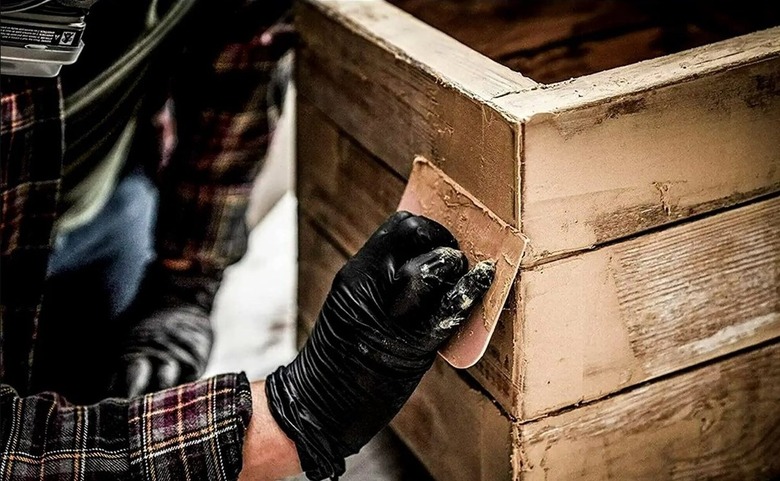How To Use Bondo For Wood Repair
We may receive a commission on purchases made from links.
Bondo auto body filler has been the go-to product for fixing dents and holes in auto bodies since 1955, and it turns out you can use Bondo for wood repair too. In fact, the widespread use of Bondo for furniture repair among other things prompted the company to introduce Bondo Wood Filler, which is a product better suited for filling wood than the original one. If you look at the material data safety sheets for both products, you'll find that the original product contains polyester resin, while the wood filler doesn't.
That's an important difference, but apart from that, the methods of using the two products are pretty much the same. Both are light-colored putties (the wood filler has a wood tone), and both undergo a curing process when you add the hardener supplied in the package. Once you mix in the hardener, the putty hardens quickly (typically in five to seven minutes), so the secret to patching wood with Bondo is to work fast because you don't have much time.
Stick With Bondo Wood Filler for Wood
Stick With Bondo Wood Filler for Wood
The polyester resin in the original Bondo auto body filler is a plastic. It's very hard when it sets, but it doesn't have much flexibility. That's fine when you're repairing metal because metal doesn't flex very much, but wood is a different story. It expands and contracts with changing temperatures and humidity, which is why some woodworkers caution against using Bondo auto body filler for wood repair. Repairs don't last.
The main ingredient in Bondo wood filler is benzoyl peroxide, a topical cream widely used to treat acne, and it's fortified with calcium sulfate, zinc stearate, iron oxide, and other iron compounds. The exact chemistry is a trade secret, but the main thing is that the wood filler contains no plastics that can become brittle and crack. It makes longer-lasting repairs to wood than auto body filler, especially on exterior surfaces.
Things Needed
-
Piece of cardboard or plastic
-
Primer (optional)
-
Paint (optional)
How to Use Bondo for Wood Repair
1. Clean the Surface
Wash any greases or oils from the surface to be repaired using soap and water and let the wood dry thoroughly. If the wood is rotted, application of Bondo Rotted Wood Restorer is recommended. Sand the surface with 80- to 120-grit sandpaper to remove splinters.
2. Mix the Product With Hardener
Use a putty knife to deposit putty onto a clean, flat surface, such as a piece of cardboard or plastic. For a typical repair, a circle about 3 inches in diameter and 1/2 inch thick is usually sufficient. It's important not to mix more than you can use in about 10 minutes because you'll have to discard the unused portion after that time. Add a 3-inch bead of hardener from the tube and then mix the two together until the color is uniform.
3. Apply the Mixture to the Wood
Use a putty knife to trowel the mixture into the cracks and holes on the wood and scrape away any excess.
Tip
If you need to fill a hole that goes all the way through the wood, cover the back of the hole with wood or cardboard and then trowel in the filler. Keep the back of the hole covered until the filler sets.
4. Sand the Filler
Let the filler completely harden, which could take up to two hours, and then sand it flat with 80- to 120-grit sandpaper. If you want a completely smooth surface, use fine-grit sandpaper to feather the edges of the filler into the wood.
5. Stain or Paint
You can stain Bondo wood filler, but it doesn't take stain as well as wood and will probably look different. It's usually a better idea to hide the repair with a coat of paint, and if you do this, apply primer first to ensure good paint adhesion.
